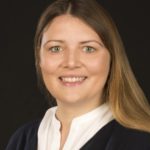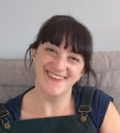Understanding MRI: Reflections from the team
In 2020, members of the Physics, Imaging Support, qMAP-PD and PLORAS teams from across the Wellcome Centre for Human Neuroimaging (WCHN) came together to deliver a multi-disciplinary public engagement project, Understanding MRI. Together with volunteers who participate in the Centre’s research, they co-created an animation to explain a core aspect of magnetic resonance imaging (MRI). You can find out more and watch the animation here.
The core Understanding MRI team is made up of
- Dr Nadine Graedel, an MRI physicist and research fellow
- Kate Ledingham, a researcher and PhD student in the PLORAS team
- Megan Creasey, a radiographer and head of imaging support at the WCHN
This core team has also been supported by Joanne Thomas (Public Engagement), Nadege Corbin (Physics team), Nicky Smith (qMap-PD team) and Anisha Desai (PLORAS team)
In this blog piece, the team have reflected on their experiences leading this project.
 Dr Nadine Graedel:
Dr Nadine Graedel:
The physics team at the WCHN has been involved in several public engagement activities over the past few years, such as the In2Science project. However, as a team, we hadn’t led on a public engagement project before. I had always assumed that visitors to the Centre might be more interested to learn about the brain and the neuroscience projects that go on at the Centre, rather than hearing about the more technical aspects of the work we do here. But in early 2020, I was encouraged by the Centre’s Public Engagement team to think about how our physics group could get more involved in leading on public engagement. The first thing that came to mind was that we often get lots of interesting questions from people who volunteer in our research about how MRI works. It can be tricky to give a good short and clear answer to respond to these great questions. So, I thought that trying to better understand what types of questions participants have and how we can answer them might be a good and useful challenge. To do this, we got in touch with other teams across the Centre, who work more closely with research volunteers who could join the Understanding MRI team and help us to develop this project.
 Kate Ledingham:
Kate Ledingham:
In order to capture the views of people who commonly visit the centre, we decided to survey current and former participants of the PLORAS and qMAP-PD studies to find out what they would like to know about MRI. Creating the survey was quite challenging; we wanted to target topics that were within the physics arena, whilst also allowing room for respondents to come up with new ideas, and make sure that the survey was easy to complete.
As a member of the PLORAS team, it was particularly important to me that the survey was accessible to people with aphasia, as they form a large proportion of our participants, and we wanted to ensure they had equal opportunity to express their views. We tried to keep the language as clear as possible, use relevant and informative pictures, and provide opportunities to give responses through visual ratings scales, with optional free text responses. We received a great response to the survey, and this was a great reminder of the amount of interest, curiosity and desire to contribute to research that I’ve encountered previously amongst stroke survivors through our other public engagement events.
Early on, we thought that videos would be the best format to answer the questions with, as it makes the content easily accessible. After selecting the most popular question from the survey, we started sketching out different ideas and created a draft storyboard. We had some initial ideas of how we could explain the question but did not know whether the difficulty and speed of this would be appropriate for our target audience. Therefore, we decided to hold three focus groups during the video production process to really shape and develop the video.
Although I have facilitated many conversation groups with people with aphasia in the past, hosting events online was a new challenge, and I was unsure how accessible participants would find communicating over video call. Once we overcame some initial issues accessing the call, our group of 5 PLORAS and QMap-PD participants were enthusiastic and forthcoming with their opinions, and really helped to shape the video. Incorporating their feedback alongside feedback from colleagues in the Centre and translating this into concrete instructions for our fantastic illustrator Alice, required some speedy work, but we were able to pull all the perspectives together, and the research participants were very positive in their response to the final video and the experience of taking part.
 Megan Creasey:
Megan Creasey:
Working with a multi-disciplinary team has been a highlight of working on this project; especially during the lockdown periods. We are all used to working with multidisciplinary teams – however this was quite different from our day-to-day collaborations. For me, it highlighted that even for those in the team who have spent a lot of time studying MRI – there are so many nuances and potential areas of confusion.
To be able to accomplish a video that was both accurate and accessible, really depended on the team as a whole and that everyone could share ideas and feel respected, even if their ideas did not make it into the project. Working alongside the animator also helped us to refine these ideas, as well as give us some new perspectives, alongside a fascinating insight into how our ideas came to life.
Overall – this has been a very enjoyable and successful team project made possible by our wonderful public engagement team – in particular Jo Thomas – thank you!
